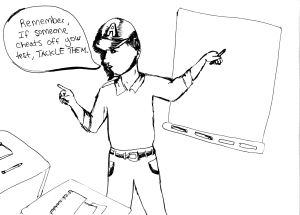
Students sometimes see a teacher twice a day, once in the classroom and again at practice, because some Aragon teachers serve as coaches for Aragon sports teams.
“My first year coaching was before I started teaching, but ever since I’ve been teaching I’ve been a coach,” science teacher and track coach Asif Rahman says. “Aragon is near my house and I wanted to [teach and coach] in my community.”

There are several advantages to teacher-coaching, one being a better understanding of students both inside and outside of the classroom.
U.S. history teacher William Colglazier, a former girls’ soccer coach says, “[Teacher-coaches] get to see the students in a different light. Seeing a somewhat [quiet], more reserved kid go to the soccer field and be aggressive was great. You also get to be more joking and jovial, so it’s a different atmosphere to interact with the kids.”
Coaching also helps students develop a closer relationship with their teacher-coach. “[Teacher-coaches can get] kids to achieve things they didn’t originally think they could do,” Rahman says. “[As] a coach, it’s much easier to do because you get to spend so much more time with the kids, so you have a much stronger connection. In the classroom, you don’t get as much time because there’s a much larger ratio of students to teachers, so I don’t think you get to have the same impact as you do when you’re coaching.”
Former Aragon wrestling coach Steve Ratto adds, “You get to know [students] a lot more when they’re on your team because you get to see them more often. I think the connection with most of the students, getting to know them and who they were, was probably the best part.”
A student taking the teacher’s class before being coached by him or her in sports 000can be beneficial as well.
Junior Christina Tun Zan had teacher-coach Annette Gennaro as her P.E. teacher her freshman year and her volleyball coach sophomore year. “I think I have more of a connection with [Gennaro] than I would have had if she wasn’t my teacher,” Tun Zan says. “It contributed to how she saw me on the volleyball court because she knew what I was like in a sports setting.”
This relationship can improve a student’s grades. Rahman says, “I know kids that have gotten A’s in my class, which is not an easy class to get an A in, who never get A’s in science classes. Because I’m their coach, they want to really impress me.”
Senior Lindsay Block, who had both Guy Oling, her golf coach, and Asif Rahman, her track and field coach, as teachers, adds, “[Teacher-coaches] are definitely more understanding about about your homework when you’re playing a sport. I had to miss Mr. Rahman’s class a few times because of golf and he was understanding about it.”
Despite its many benefits, coaching an extracurricular sport as a teacher has its fair share of challenges.
Rahman says, “Aragon, as a teaching culture, has a lot of expectations. There’s a lot of outside time you have to spend in order to be successful. To do coaching on top of that can be very difficult.”
The time spent coaching takes up time that would otherwise be spent on lesson plans or grading, leaving teachers pressed for time during their sports season.
“Time commitments are always there. During the wrestling season when there was practice after school, it was tough when [there were students] who needed help after school,” Ratto says.
“Trying to find that balance—[I was] kind of torn. So [I ended up] using other time like at lunch and other times when I was free to do everything I could.”
He adds, “I just stopped coaching last year, but when things are more solid with AP Physics and the new curriculum, I would think about coaching again.”
The personal lives of teachers may also be difficult to manage while coaching. “I had a kid the year before I stopped [coaching]. I thought I could keep doing it, but there [are] just not enough hours in the day to do both as well as I could,” Colglazier says. “I couldn’t be a good husband, good father, good coach. It was hard to balance both. The weird thing was that I was so competitive that I would sacrifice my attention to my family [to coach]. My priorities weren’t in the right place.”
However, Ratto says, “It is a big time commitment, but teachers do manage. Aragon has a high standard of teachers who have been coaching here for a while. They handle the time commitment really well, and I think that teachers that are new to coaching see that and hold themselves to a higher standard as well.”
Colglazier says, “Every time playoffs come around I think, ‘Oh, gosh, I want to get back out there!’ But getting home at 6 p.m. four months out of the year is just not feasible. Once [my kids] are of the age where they have some activities too, I would love to go back.”
He says, “I have very, very fond memories. But anything that is worth doing is going to be hard, so [coaching] was hard work, but it was super rewarding.”



